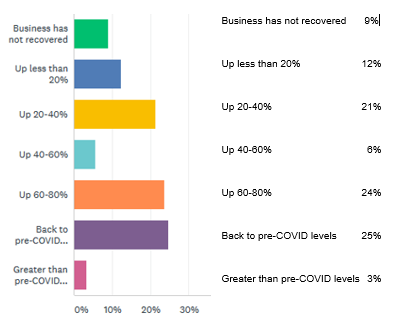SMU Data and Models

SMU Market Trends: Measuring the Recovery
Written by Tim Triplett
August 20, 2020
For more than 28 percent of steel buyers, business is back to pre-COVID levels already, while at the other end of the spectrum 9 percent have seen little or no recovery. For the vast majority in between, the recovery process is a slow and ongoing one.
In the latest market canvass this week, SMU asked: How much has your business recovered from the low point you experienced after the virus hit? The response:

Calculated as a weighted average of all responses, the typical company is back roughly 60 percent from the depths of the drop-off seen in April and May when action to stem the spread of the coronavirus disrupted the economy.
The impact of the pandemic has been uneven from company to company, depending on their location and the markets they serve. Suppliers to the automotive sector suffered among the worst when the auto plants shut down in April, but have recovered among the best since vehicle production has resumed. Those serving residential construction report positive activity; commercial construction not as much. GDP in the Midwest and South/Central regions has suffered less than the Northeast, for example.
Here’s what a few respondents to SMU’s questionnaire said this week:
“Our business is improving weekly and should continue unless our governor(s) decide another lockdown is in order.”
“Demand for our industry’s products are at an all-time high due to the pandemic.”
“We are heavily construction-oriented, so short-term we were the least impacted. We are more concerned with later in the fourth quarter and first half of 2021 that commercial and government/institutional spending will be revised and projects for new building and renovations will be removed or postponed to later dates.”
“It’s hard to say how much we’ve recovered. We have been struggling not so much due to COVID-19 shutdowns but due to low U.S. prices, trade tariffs and an environment not favorable for imports.”
“Business is better, but very competitive.”
“We never really saw a decrease. We are up around 11 percent year to date compared to 2019.”
“We’re at about 90 percent of pre-Covid-19 levels.”

Tim Triplett
Read more from Tim TriplettLatest in SMU Data and Models

SMU’s June at a glance
A look at SMU data for the month of June.

SMU Survey: Buyers’ Sentiment rebounds from multi-year low
Both of SMU’s Steel Buyers’ Sentiment Indices edged higher this week. Current Sentiment rebounded from a near five-year low, while Future Sentiment rose to a two-month high

SMU flat-rolled market survey results now available
SMU’s latest steel buyers market survey results are now available on our website to all premium members.

SMU Survey: Sheet lead times pull back after early-June blip, plate holds
Following the uptick seen two weeks ago, lead times eased this week for all four sheet products tracked by SMU, while plate lead times held steady, according to this week’s market survey.

SMU Survey: Pricing power abruptly shifts to steel buyers
The majority of steel buyers responding to our latest market survey say domestic mills are more willing to talk price on sheet and plate products than they were earlier this month. Sheet negotiation rates rebounded across the board compared to early June, while our plate negotiation rate hit a full 100%.
